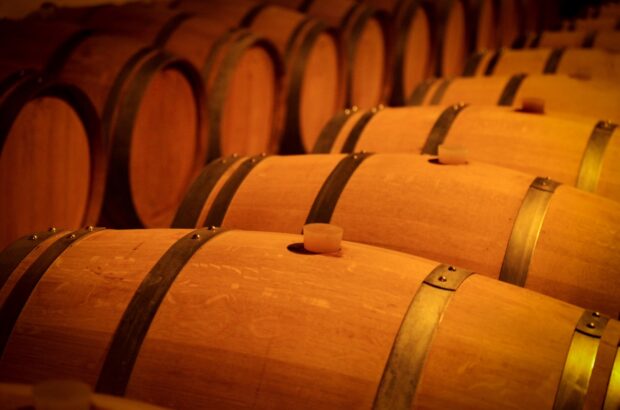China’s vast landscape and scattered plantings pose challenges to defining its wine regions. Our simple guide starts with the three generic wine districts, then details the provincial wine regions of each, and finally identifies the terroir-driven sub-regions.

Map credit: JP MAP GRAPHICS LTD
North China (West) Wine District
XINJIANG
This inland region boasts the largest area under vine in China and is the country’s main source of table grapes. With sufficient sunshine and land, Xinjiang saw a rapid increase in wine grape plantings in the past 20 years. The key sub-regions of Xinjiang are:
Yili Valley
Deep in the West Tianshan Mountains, the Yili Valley is sandwiched between ridges in the north and south. Warm Atlantic air is captured here, bringing annual rainfall of 400mm. It’s Xinjiang’s most humid sub-region, and one that prides itself on the diversity of grapes.
Producers to know: Silk Road Winery, Yizhu Winery, Chateau Crescent.

The natural views near the Kuerdening vineyard of Silk Road, located in Yili Valley, Xinjiang. Credit: Silk Road Winery
Yanqi Basin
This is a Mesozoic rift basin between the main and branch ranges of the Tianshan Mountains. The snowmelt-formed Bosten Lake, boasting 1,646km2 (in 2020), moderates its continental climate, which sees only 80mm of rain annually.
Producers to know: Tiansai Vineyards, Zhongfei Winery, Xiangdu Winery, Chateau Guofei
Tianshan Mountain North
This expansive sub-region encompasses the vast north foothills of the east-west-oriented Tianshan Mountains. The big cities located within its realm guarantee a market for wine production. At 44°N latitude, it is China’s most northerly wine region for dry wines.
Producers to know: Citic Niya, Chateau Changyu Baron Balboa, Tangtingxialu Winery
Turpan-Hami Basin
With less than 20mm of annual rainfall, this dry, hot sub-region relies on the ancient ‘qanat’ irrigation system which transports groundwater from a series of sloping underground tunnels. It is a source of characterful sweet wines.
Producers to know: Chateau Loulan, Puchang Vineyard
HEXI CORRIDOR (GANSU)
Gansu is not a widely known region due to its long, narrow landscape and the subsequent inconvenience of transport. Wuwei and Zhangye are the key sub-regions here, with Pinot Noir and Welschriesling the top performers in this cool, continental region.
Producers to know: Mogao Wine, Qilian Wine Company, Guofeng.

Sunset over vineyards in the Ningxia wine region. Credit: Ningxia Wine Bureau
HELAN MOUNTAIN EAST (NINGXIA)
Among China’s wine provinces, Ningxia stands out for the significant role it plays in the local economy. This semi-desert region gets only 200mm of rain a year but is nourished by the Yellow River. Early spring frost is the main challenge. The sub-regions are:
Shizuishan
This often-overlooked northerly sub-region has limited land under vine, yet showcases quality wines.
Producers to know: Chateau Hedong, Jiuximing Zhuang Co
Yinchuan (incorporating Helan)
Shielded by the Helan Mountains to the west, Yinchuan, the provincial capital, is Ningxia’s main sub-region at 1,000m-1200m altitude. Rocky in the north (especially in Jinshan), vineyards high up on steep slopes ripen early; the flatter areas in the south have mixed soils of gravel, silt and clay. Nearly half Ningxia’s wineries are based here, including its oldest producer, Xixia King.
Producers to know: Helan Qingxue, Longyu Estate, Silver Heights, Copower Jade, Lansai Winery, Devo Winery, Chandon Ningxia (LVMH), Helan Mountain (Pernod Ricard), Chateau Terroir (GreatWall), Kanaan Winery and Legacy Peak.
Qingtongxia
Near the southern end of the Helan Mountains, aerated by chilling winds from the Gobi desert. Well-drained sandy soils slope from southwest to northeast.
Producers to know: Xige Estate, Huahao, Stone & Moon
Hongsipu
The southernmost sub-region in Ningxia, with the highest average altitude of 1,200m. Barely protected from cold spells from the nearby desert, Hongsipu faces a higher risk of frost in spring.
Producers to know: Dongfang Yuxing, Huida Sunshine
SHANXI
Wine plantings in Shanxi are concentrated in the Taiyuan Basin, bordering the Loess Plateau. Despite the limited area under vine, it’s regarded as a quality wine region.
Producers to know: Grace Vineyard, Chateau Rongzi
WUHAI
This Mongolia region borders Ningxia to the south, where the Helan Mountains taper off; the Yellow River enters from the south. Despite a long history of viticulture, there aren’t many wineries.
Producer to know: Jiolis Winery
SHAANXI
Home to Northwest A&F University, China’s first with an oenology college and the cradle of Chinese winemakers. The region’s heritage (the Terracotta Army is in the provincial capital, Xi’an) draws close to a million tourists a year, nourishing its booming wine tourism.
Producers to know: Domaine de Jade, Changyu Chateau Rena
Southern Wine District
YUNNAN, SICHUAN, TIBET
Located between 25°N and 30°N latitude, vineyards dot the upper valleys of the Lancang, Nu, Jinsha, Dadu and Min Rivers between 1,600m and 2,800m. The junction of these three regions gets ample sun and moderate rain, and vines can survive the winter without extra protection. However, scattered vineyards are often planted on steep slopes, making them labour-intensive to cultivate. The lack of skilled workers is another issue.
Producers to know: Ao Yun (LVMH), Shangri-La Winery, Xiaoling Estate.
The ultra-high altitude vineyards in Sangri County, Tibet, between 3,563m and 3,631m, were recognised in 2018 as the world’s highest by the Guinness World Records.

Vineyards at Sinong village, Yunnan. Credit: Domaine Ao Yun
Other Southern regions
Vineyards are found in the joint section of Henan, Anhui, Shandong and Jiangsu provinces (known as the Yellow River Old Course region). But the area under vine is shrinking due to heavy disease from wet summers. Further south, Guangxi, Hunan, Jiangxi and Fujian provinces make wines with indigenous varieties such as ‘furry grape’ (Vitis quinquangularis Rehd) and ‘spiky grape’ (Vitis davidii).
North China (East) Wine District
SHANDONG
Shandong is the main wine region in China, with the Shandong Peninsula its heart. It is especially advantageous among China’s northern regions as there is no need to bury vines in winter. Annual rainfall is about 600mm and mostly falls in summer, which reduces sunshine hours and increases pressure on disease and pest control during the growing season.

Chateau Changyu Tinlot, Yantai, Shandong. Credit: Chateau Changyu Tinlot
Yantai
The most important sub-region in Shandong, with the Penglai area having the majority of vines.
Producers to know: Changyu, Domaine de Long Dai (Domaines Barons de Rothschild Lafite), Cofco GreatWall Penglai, Weilong, Longting, Junding
Qingdao
Further south on the Shandong Peninsula, Qingdao is home to several producers whose white wines have gained a passionate following.
Producers to know: Huadong Parry Winery, Chateau Nine Peaks
HEBEI
In production volume and sales value, Hebei ranks second only to Shandong. Surrounding the Chinese capital, Hebei’s most important sub-regions are Huailai, northwest of Beijing and Jieshishan, to the northeast.
Huailai
A sub-region with diverse microclimates, located in a small basin shielded by the Yanshan Mountains and shaped by the Guantin Reservoir and multiple river valleys. Dragon Eyes, a pink Vitis vinifera variety believed to have been planted in China for 800 years, is the main grape, once very popular on the domestic market. Marselan (a French crossing of Cabernet Sauvignon and Grenache, hoped to become China’s poster grape) was first introduced here.
Producers to know: China GreatWall, Chateau Sungod (GreatWall), Domaine Franco-Chinois
Jieshishan
Lying near the Bohai Sea, this sub-region has an annual rainfall of 700mm. Despite the moderating ocean influence, vines have to be buried in winter and the humidity during growing season makes disease and pest control a challenge.
Producers to know: Cofco Huaxia GreatWall, Bodega Langes, Maotai (mainly for Baijiu spirits)
BEIJING & TIANJIN
As the political and cultural centre of China, Beijing is an important region both for wine consumption and production. Boutique wineries are scattered across the sub-regions of Yanqing in the northwest (adjacent to Huailai), Fangshan (Chateau Lion) in the southwest and Miyun (Chateau Afip, p86) in the northeast, although are mostly on small scales due to the limited land resources near the capital. Tianjin became home to the first Sino-foreign joint wine venture, when Tianjin Dynasty Winery was founded in 1980 between the municipal government and the French spirits giant Rémy Martin. The local speciality Muscat Hamburg was used to make the estate’s first wines.

The vineyards of Golden Icewine Valley in winter, located in Huanren, Liaoning. Credit: Golden Icewine Valley.
JILIN & LIAONING
Jilin, at 42°N latitude, is home to the native mountain grape Vitis amurensis. This variety can survive harsh winters and is widely used by Chinese viticulturists to crossbreed with Vitis vinifera and develop cold-resistant hybrids, aiming to reduce the costs of vine burying. Amurensis grapes contain high levels of anthocyanins and acid, but sugar levels are low, so chaptalisation is a must.
Abundant snowfall and the moderating Huanren Lake provide Liaoning’s Huanren County with the perfect conditions to make ice wine, particularly from its extensive plantings of Vidal.
Producers to know: Golden Icewine Valley, Sanhe Cailonglin Winery.
Top five regions under vine in China
1. Helan Mountain East (Ningxia) 40,000ha
2. Xinjiang 20,000ha
3. Shandong 17,000ha
4. Gansu 10,000ha
5. Hebei 8,700ha
Top five most planted red and white grapes in China
Red: Cabernet Sauvignon, Merlot, Cabernet Gernischt, Marselan, Syrah
White: Chardonnay, Vidal, Welschriesling, Petit Mengseng and Muscat Hamburg
(Source: Regional wine bodies, 2023)







